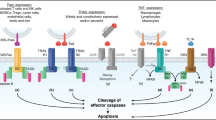Abstract
Fas (Apo-1/CD95) is a cell-surface protein that is responsible for initiating a cascade of proteases (caspases) culminating in apoptotic cell death in a variety of cell types. The function of the Fas/FasL system in the dampening of immune responses to infectious agents through the autocrine deletion of activated T cells has been well documented. More recently, it has been proposed that tumor cells express FasL, presumably to avoid immune detection. In this review, we focus on the role of the interaction of Fas and FasL in the modulation of antitumor responses. We critically examine the evidence that FasL is expressed by tumor cells and explore alternative explanations for the observed phenomena in vitro and in vivo. By reviewing data that we have generated in our laboratory as well as reports from the literature, we will argue that the Fas/FasL system is a generalized mechanism used in an autocrine fashion to regulate cell survival and expansion in response to environmental and cellular cues. We propose that FasL expression by tumor cells, when present, is indicative of a perturbed balance in the control of proliferation while “immune privilege” is established by “suicide” of activated antitumor T cells, a form of activation-induced cell death.
Similar content being viewed by others
Author information
Authors and Affiliations
Additional information
Received: 5 May 1998 / Accepted: 20 May 1998
Rights and permissions
About this article
Cite this article
Chappell, D., Restifo, N. T cell–tumor cell: a fatal interaction?. Cancer Immunol Immunother 47, 65–71 (1998). https://doi.org/10.1007/s002620050505
Issue Date:
DOI: https://doi.org/10.1007/s002620050505




